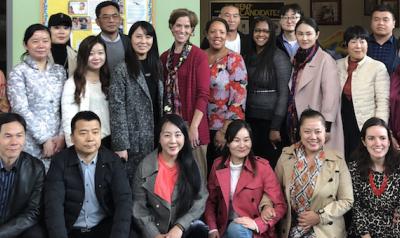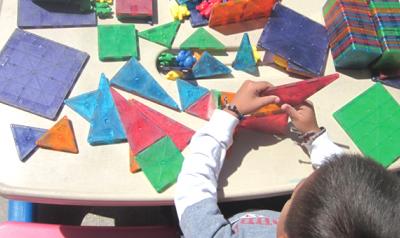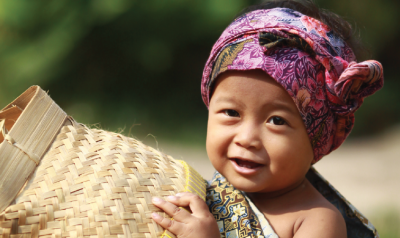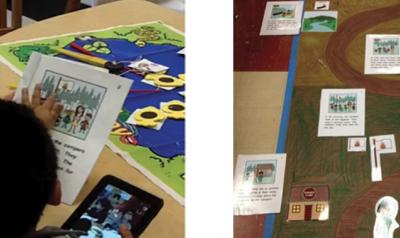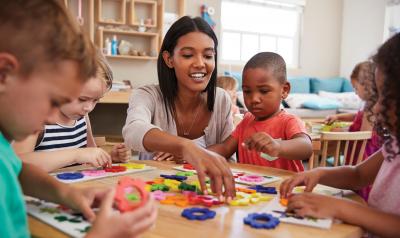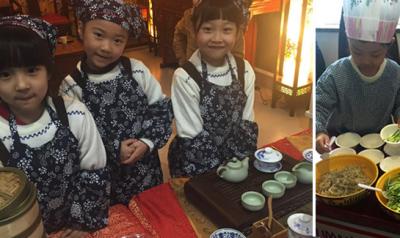Globally-Focused and Translated Blogs, Books and Articles

You are here
NAEYC is working to highlight global efforts to advance ECE and provide wider access to our resources in a variety of languages. Explore blogs on international topics, as well as translated position statements, articles, and books:
NAEYC Resources in 中文, Español, العربية, فارسی
Strategic Direction - In Chinese, Spanish and Arabic!
Arabic Resources (الموارد بالعربية)
نظر صفحتنا الموارد باللغة العربية.
كتب (Books)
- المرح الجاد: كيف يزيد اللعب الموجه فرص التعلم لدى الأطفال (ٍSerious Fun: How Guided Play Extends Children's Learning, E-Book)
- أسئلة كبيرة لعقول يانعة (Big Questions for Young Minds: Extending Children's Thinking)
بيانات الموقف (Position Statements)
- الممارسات الملائمة تطوريًّا (Developmentally Appropriate Practice)
مقالات (Articles)
- الإحساس بالمكان: الجغرافيا البشرية في فصول الطفولة المبكرة (A Sense of Place: Human Geography in the Early Childhood Classroom)
- ما وراء طبطبة الكرة: المعلمات والأطفال الفطم يدرسون الفيزياء (Beyond Bouncing the Ball: Toddlers and Teachers Investigate Physics)
- اللعب النشط داخل الفصل (Bringing Active Play Indoors)
- علاقات الرعاية: هي أساس التطور المبكر للدماغ (Caring Relationships: The Heart of Early Brain Development)
- محادثات مع الأطفال! الأسئلة ال تي تحفّزالمحادثات وتعمّق الفهم (Conversations with Children! Questions that Spark Conversations and Deepen Understanding)
- محادثات مع الأطفال! استخدام الأسئلة خلال وقت الأركان التعليمية (Conversations with Children! Using Questions during Center Time)
- عشرون سؤالاً للمعلمات: قائمة متعلقة بالممارسات الملائمة نمائياً (20 DAP Checklist Questions for Teachers)
- ممتع ومثرٍ: الدليل إلى الصرامة الأكاديمية الملائمة من الناحية التنموية (Engaging and Enriching: The Key to Developmentally Appropriate Academic Rigor)
- تعزيز العمل الروتيني الخاص بتغيير الحفاضات للطفل: العناية والتواصل والتطور (Enhancing the Diapering Routine: Caring, Communication, and Development)
- بدءًا من محاكاة التصميم وصولًا إلى دراسة الرياضيات بالفصول الدراسية لمرحلة الطفولة المبكرة (From Design Copying to Mathematics in the Early Childhood Classroom)
- مساعدة الأطفال الصغار على تعلم اللغة: الآراء المستمدة من البحوث (Helping Young Children Learn Language: Insights from Research)
- كیف تدعم التجارب الفنیة التي تركز على المعالجة الأطفال في مرحلة ریاض الأطفال (How Process-Focused Art Experiences Support Preschoolers)
- تطبيق نهج التعلم القائم على المشاريع في فصول الدمج: المحاولة الأولى لإحدى المعلمات لاستخدام التعلم القائم على المشاريع (Implementing the Project Approach in an Inclusive Classroom: A Teacher’s First Attempt With Project-Based Learning)
- انظر واسمع وتعلم: اللطف في المعاملة (Look, Listen, Learn: The Kindness Movement)
- أكثر من مجرد أساس: الأطفال الصغار دارسون متفوقون للعلوم والتكنولوجيا والهندسة والرياضيات (More Than a Foundation: Young Children Are Capable STEM Learners)
- الملاحظة والتخطيط والتوجيه: تلبية متطلبات المعايير من خلال اللعب (Observing, Planning, Guiding: How an Intentional Teacher Meets Standards through Play)
- تعلم الحساب من خلال اللعب في سياق المعايير التعليمية والمساءلة (Playful Math Instruction in the Context of Standards and Accountability)
- تعزيز تعلم الكتابة لمرحلة ما قبل المدرسة (Promoting Preschooler's Emergent Writing)
- تعزيز الصحة الاجتماعية والعاطفية للأطفال الصغار (Promoting Young Children’s Social and Emotional Health)
- الاحترام هو جوهر رعاية الرضع والفطم والقيام على شؤونهم (Respect: The Heart of Serving Infants and Toddlers)
- استكشاف الرياضيات مع الرضع والفُطم: فوائد الكتب واللغة التي تتناول المفاهيم الرياضية (Rocking and Rolling—Exploring Math with Infants and Toddlers: The Joys and Benefits of Math-Based Books and Language)
- الهواء النقي والمتعة والاستكشاف: أهمية اللعب الخارجي في التطور الصحي للأطفال (Rocking and Rolling—Fresh Air, Fun, and Exploration: Why Outdoor Play Is Essential for Healthy Development)
- التناغم والتآزر - يد واحدة لا تص فِّق: دور التنظيم المشترك في بناء مهارات التنظيم الذاتي عند الطفل (Rocking and Rolling—It Takes Two: The Role of Co-Regulation in Building Self-Regulation Skills)
- مشاركة التساؤل والتعجب: العلوم برفقة الرضع والفطم (Rocking and Rolling—Sharing the Wonder: Science With Infants and Toddlers)
- لماذا تدريس الرضع والفطم مهم؟ (Rocking and Rolling: Why Teaching Infants and Toddlers is Important)
- علم الدماغ واللعب الموجّه: تألیف قصة (The Case of Brain Science and Guided Play: A Developing Story)
- مشروع مركز القيادة: التخلص من التوتر المرافق للمنهاج الدراسي المستجد (The Command Center Project: Resolving My Tensions with Emergent Curriculum)
- الفوائد العديدة المترتبة على عملية استمرارية الرعاية للرضع والأطفال الصغار والعائلات والموظفين العاملين في مجال تقديم الرعاية (The Many Benefits of Continuity of Care)
- "هناك قصة في صورتي" ربط الفنون ومهارات القراءة والكتابة والعمل الدرامي من خلال فن سرد القصص في فصل من فصول الروضة (There's a Story in My Picture!” Connecting Art, Literacy, and Drama through Storytelling in a Kindergarten Classroom")
- فجوة الكلمات: السنوات الأولى تصنع الفرق (The Word Gap: The Early Years Make the Difference)
- اثنا عشر مبدأ من مبادئ تطور الطفل وتعلمه (Twelve Principles of Child Development and Learning that Inform Practice)
- التفاهم مع الأطفال الذين يمارسون سلوك العض وطريقة الاستجابة لهم (Understanding and Responding to Children Who Bite)
- استخدام أنواع متعددة من النصوص والكتب لتوجيه تعلّم الأطفال (Using Multiple Texts to Guide Children's Learning)
- استخدام التقنية لتحسين وتعزيز تعلم الأطفال في المنزل والمدرسة: إقامة العلاقات هي الأساس (Using Technology to Enhance Children’s Learning at Home and at School)
- أربعة عشر يومًا لاستنبات نباتات السلطة: استخدام التعلم القائم على المشاريع لاستنبات نباتات المايكروغرين (14Day Salad: Using Project-Based Learning to Grow Microgreens)
موارد للعائلات (Resources for Families)
مقالات (Articles)
- الحديث عن الرياضيات مع الرضع والفطم (Math Talk with Infants and Toddlers)
رسالة في حقيبة الظهر ™ (™Message in a Backpack)
- الفقاعات (Bubbles)
- طرق مسلية وسهلة للعب بالرياضيات في المنزل (Fun, Easy Ways to Play with Math at Home)
- ما بعد الملعب: الرياضيات والعلم والمرح في الخارج (Going Beyond the Playground: Math, Science, and Outdoor Fun)
- توجيه سلوك طفلك (Guiding Your Child's Behavior)
- مساعدة طفلك على تعلم تحمُّل المسؤولية (Helping Your Child Learn Responsibility)
- حان وقت الاجتماع (It's Conference Time)
- اصنع موسيقى من أصوات الحيوانات (Make Animal Music)
- الرياضيات: إنها مهمة وممتعة (Math: It’s Important and Fun)
- أشياء يجب أن يعلمها كل ولي أمر حول اللعب (Things Every Parent Should Know About Play)
موارد المعايير (Standards Resources)
- معايير التعلم المبكر النمائية (متن) في المملكة العربية السعودية (Saudi Early Learning Standards)
Chinese Resources (中文资源)
请访问我们的中文資源页面.
图书 (Books):
- 严肃的乐趣:引导式游戏如何拓展儿童的学习 (Serious Fun: How Guided Play Extends Children's Learning) - E-Book
- 小脑袋,大问题:促进幼儿深度学习的高水平提问 (Big Questions for Young Minds: Extending Children's Thinking)
- 0-3岁婴幼儿发展适宜性实践 (Developmentally Appropriate Practice: Focus on Infants and Toddlers)
- 从“倒腾“开始的幼儿STEM教育 (Making and Tinkering with STEM: Solving Design Challenges With Young Children)
- 有力的师幼互动:促进幼儿学习的策略 (Powerful Interactions: How to Connect with Children to Extend Their Learning)
立场声明 (Position Statements):
- 推动儿童早期教育中的平等 (Advancing Equity in Early Childhood Education)
- 针对零至八岁幼儿的教育课程 (Developmentally Appropriate Practice) - print available in the NAEYC store
-
针对零至八岁幼儿的教育课程 (Developmentally Appropriate Practice)
在线模块 (Online Modules) - Available for licensing, contact [email protected] for more information
- 适合儿童发展的实践(DAP):专注于婴儿和学步儿童 (Developmentally Appropriate Practice (DAP) Focus on Infants and Toddlers)
- 适合儿童发展的实践 (DAP): 专注于学龄前儿童 (Developmentally Appropriate Practice (DAP) Focus on Preschoolers)
文章 (Articles)
- 引人入胜且令人受益良多:与发展相适应的学术严谨性 的关键 (Engaging and Enriching: The Key to Developmentally Appropriate Academic Rigor)
- 早教课堂上的 从图形重现到数学 (From Design Copying to Mathematics in the Early Childhood Classroom)
- 0-6 岁儿童适龄玩具的选择 (Good Toys for Young Children by Age and Stage)
- 不仅仅是基础:儿童是 出色的STEM学习者 (More Than a Foundation: Young Children Are Capable STEM Learners)
- 标准和责任背景下的 游戏式数学教学 (Playful Math Instruction in the Context of Standards and Accountability)
- 让学龄前儿童成 为生态艺术家 (Preschoolers as Eco-Artists)
- 在学前班里游戏、欢笑与学习 (Playing, Laughing, and Learning in Preschool)
- 用手机和平板电脑支持儿童的反思 (Supporting Children's Reflection With Phones and Tablets)
- 脑科学和引导式游戏的案例:正在发生的故事 (The Case of Brain Science and Guided Play: A Developing Story)
家庭资源 (Resources for Families)
文章 (Articles)
- 在家里玩音乐游戏 (Playing with Music at Home)
- “如果把颜料涂在手上会有什么害处吗?” 1-3岁学步儿在家参与感官活动的指南 ("What's the harm if I paint my arm?": A Toddler's Guide to Sensory Activities in the Home)
- 10种方法教出富有同理心的宝宝 (10 Tips for Raising a Compassionate Infant-Toddler)
- 12个提升0-3岁宝宝语言能力的方法 (12 Ways to Support Language Development for Infants and Toddlers)
书包金点子™ (Message in a Backpack™)
- 泡泡 (Bubbles)
- 日常图形 (Everyday Shapes)
- 在一起洗衣服时提高孩子语言能力的有趣方法 (Fun Ways to Build Your Child’s Literacy Skills While Doing Laundry Together)
- 在家玩转数学的欢乐及轻松之道 (Fun, Easy Ways to Play with Math at Home)
- 飞越游乐场:数学、科学和户外乐趣 (Going Beyond the Playground: Math, Science, and Outdoor Fun)
- 指导你孩子的行为 (Guiding Your Child's Behavior)
- 帮助你的孩子学会负责任 (Helping Your Child Learn Responsibility)
- 会议时间!(It’s Conference Time!)
- 制作动物音乐 (Make Animal Music)
- 数学:很重要也很有趣 (Math: It's Important and Fun)
- 与敏感儿童一同户外游乐 (Nature Play with Sensitive Children)
- 每个父母都应了解的游戏事实 (Things Every Parent Should Know about Play)
Farsi (Persian) Resources (منابع فارسی)
(Message in a Backpack ™)™پیام در کوله پشتی
- انتخاب بهترین فعالیت های STEM (علم ، فناوری ، مهندسی و ریاضی ) برای کودک خود (Choosing the Best STEM Activities for Your Child)
- همه می توانند داستان گو باشند (Everyone Can Be a Storyteller)
- راههای سرگرم کننده برای سوادآموزی و ادبیات در کودک هنگام شستشوی لباس (Fun Ways to Build Your Child’s Literacy Skills While Doing Laundry Together)
- فراتر از زمین بازی: ریاضی ، علوم و تفریح در فضای باز (Going Beyond the Playground: Math, Science, and Outdoor Fun)
- راهنمایی رفتارهای کودک تان (Guiding Your Child’s Behavior)
- کمک کردن به کودک تان برای یاد گرفتن مسئولیت پذیری (Helping Your Child Learn Responsibility)
- یادگیری از طریق فعالیت های روزمره (Learning through Everyday Activities)
- ساختن موسیقی حیوانات (Make Animal Music)
- بازی با طبیعت برای کودکان حساس (Nature Play with Sensitive Children)
- هر چیز و همه چیز را با کودک خود بخوانید (Read Anything and Everything with Your Child)
- جرقه تفکر خلاقانه با سوالات باز (Spark Creative Thinking with Open-Ended Questions)
- صحبت کنید! (!Talk It Up)
- تمامی آنچه که هر پدر و مادری باید درباره بازی بداند (Things Every Parent Should Know about Play)
-
Spanish Resources (Recursos en español)
Visite nuestra página de recursos en español para más.
Módulos en línea (Online Modules):
- Ampliando el Aprendizaje de los Niños a Través del Juego Guiado (Extending Children's Learning Through Guided Play)
Publicaciones españolas en la tienda (Spanish Publications in the Store):
- Diversión en serio: Cómo el juego guiado amplía el aprendizaje de los niños (Serious Fun: How Guided Play Extends Children's Learning) E-Book
- TYC artículos (TYC Articles)
Declaraciones de posición (Position Statements):
- El Código de Conducta Ética y Declaración de Compromiso (Code of Ethical Conduct and Statement of Commitment)
- La evaluación y clasificación de niños que aprenden el inglès (Supplement on Assessing Young English Language Learners)
- NAEYC e IRA posicion acerca del aprendizaje de la lectura y la escritura (NAEYC and IRA Position on Learning to Read and Write)
- Práctica Apropiada para el Desarrollo (Developmentally Appropriate Practice)
- Promover la Equidad en la Educación Infantil (Advancing Equity in Early Childhood Education)
- Respuesta a la Diversidad Lingüística y Cultural: Recomendaciones para una Educación Infantil Eficaz (Responding to Linguistic and Cultural Diversity Recommendations for Effective Early Childhood Education)
Artículos (Articles):
- Al otro lado de la barda: Cómo incentivar a niños en edad preescolar y familias a participar en una investigación de un año sobre STEAM (Over the Fence: Engaging Preschoolers and Families in a Yearlong STEAM Investigation)
- Ambas opciones son válidas: Cómo utilizar las aplicaciones de ciencias para niños para favorecer el aprendizaje práctico y digital (Have It Both Ways: Using Children’s Science Apps to Support Hands-On and Digital Learning)
- Aprendizaje matemático —y un toque de ciencia— en la naturaleza (Math Learning—and a Touch of Science—in the Outdoor World)
- Aprovechar al máximo los textos informativos (Making the Most of Informational Text)
- Centros de aprendizaje: Arte (Learning Centers: Art)
- Centros de aprendizaje: Cocina (Learning Centers: Cooking)
- Ciencias, juego y espiritualidad: Tres foros de interés exploran la conectividad y el compromiso profundo (Science, Play, and Spirituality: Three Interest Forums Explore Connectivity and Deep Engagement)
- Cómo alimentar la capacidad de asombro: Los proyectos STEM traen alegría al salón de clases (Nurturing Wonder: STEM Projects Bring Joy to the Classroom)
- Cómo involucrar a maestros y a niños pequeños en la ciencia (Voces) (Engaging Teachers and Toddlers in Science (Voices))
- Creación de centros de aprendizaje con abundancia de lenguaje escrito (Creating Learning Centers with an Abundance of Written Language)
- Creciendo con STEM: De la estática a los circuitos: Exploraciones STEM de la electricidad basadas en la investigación (Growing in STEM: From Static to Circuits: Inquiry-Based STEM Explorations of Electricity
- Creciendo con STEM. El proceso de diseño: Prácticas de ingeniería en preescolar (Growing in STEM. The Design Process: Engineering Practices in Preschool)
- Creciendo con STEM: Recursos STEM y materiales para participar en experiencias de aprendizaje (Growing in STEM: STEM Resources and Materials for Engaging Learning Experiences)
- Cultivo de vegetales en 14 días: cómo usar el aprendizaje basado en proyectos para cultivar micro vegetales (14-Day Salad: Using Project-Based Learning to Grow Microgreens)
- De copiar diseños a las matemáticas en el aula de educación inicial (From Design Copying to Mathematics in the Early Childhood Classroom)
- Dediquémonos a la equidad. Ayudemos a todos los niños a alcanzar todo su potencial (Embracing Equity: Helping All Children Reach Their Full Potential)
- De Nuestra Presidenta. El desarrollo de liderazgo: Abrir un lugar en la mesa (Leadership Development: Making Room at the Table)
- De Nuestra Presidenta. Preguntas que iluminan y expanden el aprendizaje (Questions that Illuminate and Expand Learning)
- De Nuestra Presidenta. Entregar el testigo . . . seguir corriendo (Passing the Baton . . . Staying in the Race)
- De Nuestra Presidenta. Momento ¡ajá! de abogacía (From our President. Aha! Advocacy Moment)
- El caso de la ciencia del cerebro y el juego guiado: una historia en desarrollo (The Case of Brain Science and Guided Play: A Developing Story)
- En sus marcas, listos, aprendan! Vamos a la luna (Ready, Set, Learn! We're Off to the Moon)
- Experiencias de STEM en ingeniería basada en la comunidad en un salón de clases de segundo grado en una escuela urbana (Community-Based Engineering STEM Experiences From a Second Grade Urban Classroom)
- Experiencias Musicales (Musical Experiences)
- Explicando STEAM a los niños en edad escolar (Breaking Down STEAM for Young Children)
- Explicando STEAM a los niños en edad escolar Parte 3: Indagación. Plantear preguntas y ser solucionadores de problemas (Breaking Down STEAM for Young Children. Part 3...)
- Fomentar la curiosidad: cómo usar y crear textos informativos (Nurturing Curiosity: Using and Creating Informational Texts)
- Formar Conexiones. Nuestro lanzamiento a la luna (Making Connections. Our Moonshot)
- Formar conexiones. La obligación profesional de valorar a familias (Making Connections. The Professional Obligation to Value Families)
- Formar conexiones. La educación infantil en Suecia (Making Connections. Early Childhood Education in Suecia)
- Gimnasio para caracoles: aprendiendo con gusto recreativo en el salón de kínder (A Jungle Gym for Snails: Joyful Learning in the Kindergarten Classroom)
- Hacer que STEM sea social para motivar a los niños de preescolar (Make STEM Social to Motivate Preschoolers)
- Incorporar el conocimiento que obtienen los niños de sus hogares y comunidades: Un enfoque del hogar a la escuela para enseñar STEM en preescolar (Incorporating Knowledge from Children’s Homes and Communities...)
- Instrucción matemática lúdica en el contexto de los estándares y de la rendición de cuentas (Playful Math Instruction in the Context of Standards and Accountability)
- Inspire a los niños a pensar y actuar como científicos (Inspire Children to Think and Act Like Scientists)
- Integración de la enseñanza diestra con los medios educativos que les encantan a los niños (Joining Skillful Teaching with Educational Media Children Love!)
- La Cámara Digital: Una Herramienta Para la Enseñanza Creativa (The Digital Camera: A Tool for Creative Learning)
- La ciencia de los superhéroes (The Science of Superheroes)
- La descompuesta verdad: ¡Descubrir la descomposición! (The Rotten Truth—Discovering Decay!)
- La magia de la investigación y los cangrejos ermitaños: potenciar el desarrollo holístico en Hong Kong (Voces) (The Magic of Inquiry and Hermit Crabs: Empowering Holistic Development in Hong Kong (Voices))
- Lecciones que aprendimos de nuestras colaboraciones con las familias (Lessons Learned from Our Collaborations with Families)
- Líderes en Tiempos de Crisis: Una Maestra de Primera Infancia de Costa Rica Contribuye a los Planes Educativos para Aprendices Jóvenes (Leaders in Times of Crisis: An Early Childhood Teacher from Costa Rica Contributes Education Plans for Young Learners)
- Máquinas de hacer garabatos (Scribbling Machines)
- Más allá de botar la pelota: los niños pequeños y sus maestros investigan la física (Beyond Bouncing the Ball: Toddlers and Teachers Investigate Physics)
- Más que una base: Los niños pequeños son alumnos con capacidades STEM (More Than a Foundation: Young Children Are Capable STEM Learners)
- Matemáticas y Objetos Manipulables (Mathematics and Manipulable Objects)
- Mira, escucha, aprende. ¿A dónde va la lluvia? El papel del maestro en los descubrimientos de los niños (Look, Listen, Learn. Where Does the Rain Go?...)
- Participativo y enriquecedor: las claves del rigor académico apropiado desde el punto de vista del desarrollo (Engaging and Enriching: The Key to Developmentally Appropriate Academic Rigor)
- Promoción del aprendizaje científico de los niños paso a paso (Promoting Children’s Science Learning One Step at a Time)
- ¿Qué hay en una sombra? (What's in a Shadow?)
- Reflexión más allá de las fronteras: Educadores de preescolar de Palestina y Estados Unidos recurren a la indagación colaborativa en ciencias (Voces) (Reflecting across Borders: Palestinian and US Early Childhood Educators Engage in Collaborative Science Inquiry (Voices))
- Seis temas clave en la ciencia de la primera infancia: Presentación del ECSIF de la NAEYC, en una conferencia sobre educación de la ciencia (Six Key Themes in Early Childhood Science...)
- Un ambiente científico (A Scientific Environment)
- ¿Utilizar o no utilizar Pintrest? Elegir, usar y compartir recursos STEM de alta calidad (To Pin or Not to Pin? Choosing, Using, and Sharing High-Quality STEM Resources)
- Zapallos y Calabazas: Investigación, disección y documentación (Squash and Pumpkins: Investigation, Dissection and Documentation)
Recursos para familias (Resources for families)
Articulos (Articles)
- Alimentando al científico en tu hijo (Nurturing the Scientist in Your Child)
- Aplicaciones matemáticas, de lógica y ciencias para el aprendizaje temprano (Math & Logic and Science Apps for Early Learning)
- Charla de matemáticas con bebés y niños pequeños (Math Talk with Infants and Toddlers)
- ¡Celebre el multilingüismo de su hijo! (Celebrate Multilingualism with Your Child!)
- Cómo usar y crear textos informativos en casa (Using and Creating Informational Texts at Home)
- El comienzo del kindergarten (The Beginning of Kindergarten)
- El poder de la plastilina (Playdough Power)
- Explorando el mundo de la ciencia con su hijo(a) (Exploring the World of Science with Your Child)
- Ideas para clasificar en la casa (Home Sorting Ideas)
- Juguetes como herramientas: Experiencias científicas cotidianas (Toys as Tools: Everday Science Experiences)
- Las formas geométricas de todos los días (Everyday Shapes)
- STEM (Ciencia, Tecnología, Ingeniería y Matemáticas) en el mar (STEM at the Sea)
- 10 Cajas Temáticas para Aprender (10 Prop Box Ideas: Mini Learning Centers at Home)
- 10 consejos para respaldar el aprendizaje de ciencias de su hijo (10 Tips to Support Children's Science Learning)
- 10 cosas que los padres deberían saber sobre el juego (Ten Things Parents Should Know about Play)
Mensaje en la Mochila ™ (Message in a Backpack ™):
- Ayude a su hijo a aprender a ser responsable (Helping Your Child Learn Responsibility)
- Cómo elegir las mejores actividades STEM para sus hijos (Choosing the Best STEM Activities for Your Child)
- Cómo fomentar la curiosidad: ¡Porque las mentes inquisitivas quieren saber! (Encouraging Curiosity— Because Inquiring Minds Want to Know!)
- Cómo guiar el comportamiento de su hijo (Guiding Your Child's Behavior)
- Desde recetas hasta mapas de rutas: Maneras entretenidas de aprender con información cotidiana (Recipes to Road Maps: Fun Ways to Learn from Everyday Information)
- El aprendizaje en actividades cotidianas (Learning Through Everyday Activities)
- ¡Es tiempo de conferencias! (It's Conference Time!)
- ¡Hablar! ¡Conversar! (Talk it Up!)
- Las formas de todos los días (Everyday Shapes)
- Las matemáticas: importantes y divertidas (Math: It's Important and Fun)
- Lo que los padres deben saber sobre el juego (Things Every Parent Should Know about Play)
- Los sonidos y la música de animales (Animal Music and Sounds)
- Maneras divertidas y fáciles de jugar con la matemática en casa (Fun, Easy Ways to Play with Math at Home)
- Más allá del parque matemática, ciencia y diversión al aire libre (Going Beyond the Playground: Math, Science and Outdoor Fun)
- Receta de burbujas (Recipe for Bubbles)
Nuevas Categorías de Membresía (New Categories of Membership)
Un video informativo sobre las categorías de membresía de NAEYC para aprender lo que está incluido en cada nivel y qué nivel es adecuado para usted.
Power to the Profession, Revalorizar la profesión, 职业赋能
Revalorizar la profesión (Power to the Profession):
- ¿En qué consiste "Power to the Profession"? (What is Power to the Profession?)
- CICLOS DE DECISION 345+6 Resumen Ejecutivo (Decision Cycles 345+6: Executive Summary)
- Estrategia y cronograma de ejecución de P2P (P2P Execution Strategy and Schedule)
职业赋能(Power to the Profession)
- 什么是“职业赋能”?(What is Power to the Profession?)
- 决策周期345+6 执行概要 (Decision Cycles 345+6: Executive Summary)
Globally-Focused Blogs and Articles
Hot Off the Press
Our latest global edition of Young Children, Enriching Education Around the World can be purchased from our online store or viewed online.
Don't forget to check out the Sept. 2017 edition, Global Practices That Inform and Inspire.
NAEYC's books are available in Europe, Asia, Africa, South America, Australia, and New Zealand! For international ordering through our distributors Eurospan or Login Canada please refer to our Publications Ordering Information page.
Look no further for existing translations of our books. To license translation rights for a publication, please visit our Permissions, Reprint, and Translation Requests page and look for "Translation Inquiries".

